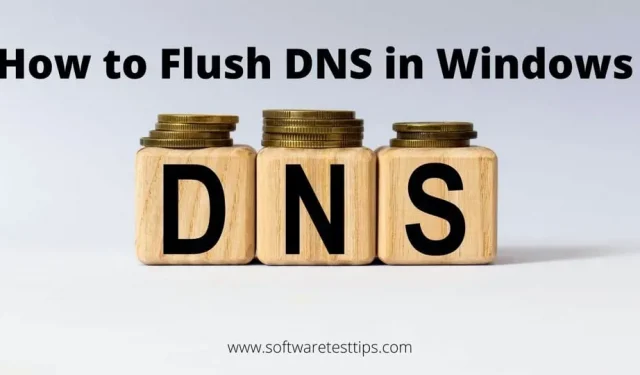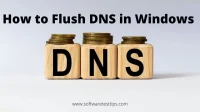The Domain Name System (DNS) converts website names to IP addresses (numeric/alphanumeric format) so that the website is loaded for users.
Simply put, DNS is responsible for loading websites on your computer. If websites do not load, clearing the DNS resolver cache may bring back websites.
This article is for you if you have a website that is not loading in your browser and you need to clear your DNS records.
What does DNS reset mean?
DNS cache flushing refers to the process of deleting the IP addresses or DNS resolver cache of an internet connection in order to fix issues related to digital security and network connectivity. The existing DNS address is removed and configured to automatically look up the DNS or IP address. You can perform this task manually or without any action.
Even though the DNS cache keeps flushing on its own due to a feature known as time to live (TTL). One particular DNS entry is valid for the lifetime. After the time has elapsed, it will reset automatically.
Generally, rebooting the router and using the ipconfig /flushdns command in the Windows 10 command prompt can help you fix this issue.
Why should you clear the DNS Resolver cache?
The following are the reasons why you need to manually flush your local DNS cache without waiting for the TTL to expire:
- 404 errors are common symptoms of bad DNS. If you see a 404 error or an old version of the website you are trying to load.
- The site may not load.
You can clear your cookies, history, and browser settings to see if the website is loading. If this is not the case, DNS flushing is your solution.
- Changing your DNS address can protect your online privacy. This can keep you safe from sites that collect your information.
- You can flush your DNS cache to prevent attackers from gaining access to your information and redirecting you to irrelevant domain sites.
Flushing the DNS Cache
3 Ways to Flush DNS Cache in Windows 10
There are three ways to clear the DNS cache in Windows 10.
1. Windows command
- Press the Windows keys plus R to launch the Windows Run utility.
- In the “Open”field, enter the following command:
ipconfig /flushdns
- Press the Enter key to clear the DNS server address.
You will see the message “Windows IP address configuration successfully flushed the DNS resolver cache”after the process is complete and the DNS cache will be changed.
2. Windows PowerShell
- Right-click the Start button or press Windows key + X to open the quick link menu.
- Select Windows PowerShell (Admin). Alternatively, you can find PowerShell and run it as an administrator.
- Enter the following command in the interface:
Clear-DnsClientCache
- Press the Enter key to run this command.
3. Command line
- Click on the search bar, type cmd and you should be able to see the command prompt window and related options. The cmd command can also be used in the Run tool to open a command prompt.
- Select “Run as administrator”from the search results.
- Type ipconfig /flushdns in the command prompt window and press Enter.
How to clear DNS Windows 7
The earlier Windows 7 also has a similar way to clear the DNS cache on your computer. It also uses the command line tool.
Here are the steps to clear the DNS cache if you are running Windows 7:
- Click the Start button in the lower left corner of the screen.
- Select the “All Programs”option and select “Accessories”.
- Locate the command line tool, right-click it, and select Run as administrator.
- Select “Yes”in the window that appears asking if you want to allow the command line to make changes to your computer. If you are not a system administrator, you will need their help to complete this operation.
- Type the ipconfig /flushdns command and press Enter to flush the DNS cache.
Once completed, you will see a message that the DNS Resolver cache has been successfully cleared.
How to Flush DNS Windows XP and Vista
The DNS cache flush process in Windows XP and Vista is very similar to the same process in Windows 7.
Here are your steps to clear the DNS cache in Windows XP and Vista:
- Press the Windows key or click the Start button to open the Start menu.
- Open All Programs and select Accessories.
- From here, open the command line tool.
- Type ipconfig /flushdns and press Enter in the command prompt window.
- You may receive the message “The action requires elevation.”In this case, the administrator must follow the procedure described above.
How to Flush DNS Mac OS X
Every version of Mac OS on your Mac has the same method to change the DNS resolver cache. But the terminal command may be different.
Here are the steps and commands to clear Mac DNS:
- Press the Option + Command + Space keys on your keyboard to open the Finder tool.
- Select “Applications”and find the “Utilities”folder.
- Open it and launch the Terminal app. Alternatively, you can launch the launcher and find the Terminal in it.
- In the Terminal, enter the following commands depending on the software version:
- Version 10.4: lookupd -flushcache
- Version 10.5 – 10.6: sudo dscacheutil -flushcache
- Version 10.7 – 10.9: sudo killall -HUP mDNSResponder
- Version 10.10: sudo discoveryutil mdnsflushcache
- Version 10.11 – 10.14: sudo killall -HUP mDNSResponder
- Enter the password and press Enter.
- A confirmation message will let you know when the DNS server address has been cleared.
How to clear DNS Google Chrome
The Google Chrome browser has its own DNS cache. This can be changed via Chrome on MacOC or Windows 10 and the steps are the same.
Here are your steps to clear your Chrome browser cache:
- Launch Chrome and enter the following in the address bar at the top:
chrome://net-internals/#dns
- Click the Clear Host Cache button to clear the DNS server.
How to Flush DNS Linux
Linux OS does not obtain a DNS address by default . Linux users have two options – flush the DNS cache or restart the Linux system service.
Here’s what you need to do:
- Launch the Terminal tool by pressing Ctrl + Alt + T on your keyboard.
- Enter the following commands, depending on the Linux service your system is running:
- Dnsmasq: sudo /etc/init.d/dnsmasq restart
- NCSD: sudo /etc/init.d/nscd restart
- BIND: this has a number of commands
- sudo /etc/init.d/named restart
- sudo rndc-exec
- sudo rndc restart


